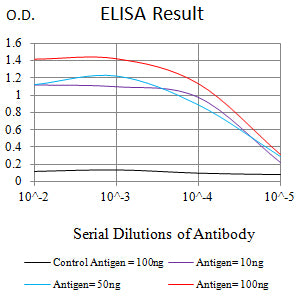
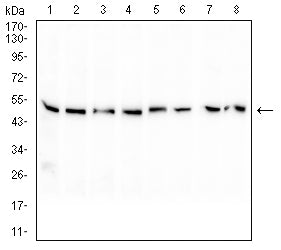
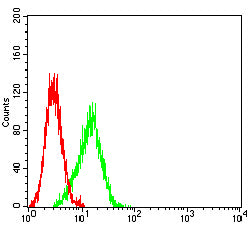
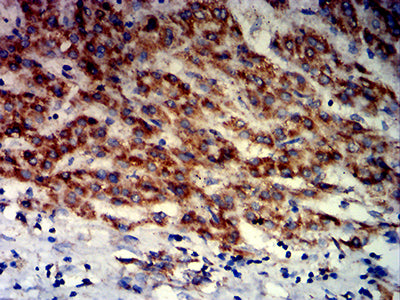
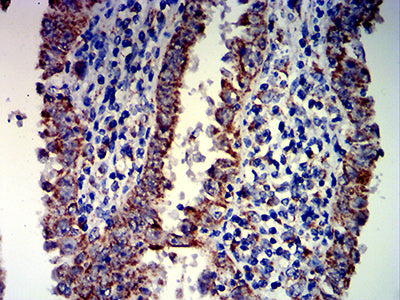
| WB | 1/500 - 1/2000 | Human,Mouse,Rat |
| IF | 咨询技术 | Human,Mouse,Rat |
| IHC | 1/200-1/1000 | Human,Mouse,Rat |
| ICC | 技术咨询 | Human,Mouse,Rat |
| FCM | 1/200-1/400 | Human,Mouse,Rat |
| Elisa | 1/10000 | Human,Mouse,Rat |
| Entrez GeneID | 7849 |
| clone | 1D6E2 |
| WB Predicted band size | 48.2kDa |
| Host/Isotype | Mouse IgG1 |
| Antibody Type | Primary antibody |
| Storage | Store at 4°C short term. Aliquot and store at -20°C long term. Avoid freeze/thaw cycles. |
| Species Reactivity | Human |
| Immunogen | Purified recombinant fragment of human PAX8 (AA: 60-261) expressed in E. Coli. |
| Formulation | Purified antibody in PBS with 0.05% sodium azide |
+ +
以下是3-4条关于PAX8抗体的参考文献及其简要摘要:
---
1. **文献名称**: *PAX8: A sensitive and specific marker for the diagnosis of renal cell, ovarian, and thyroid carcinomas*
**作者**: Tong GX, Yu WM, Beaubier NT, et al.
**摘要**: 该研究验证了PAX8抗体在免疫组化中的诊断价值,表明其在肾细胞癌、卵巢浆液性癌和甲状腺癌中高表达,而对其他器官肿瘤(如肺癌、乳腺癌)特异性较高,提示PAX8可作为鉴别上述肿瘤的重要标记物。
2. **文献名称**: *PAX8 immunoreactivity in primary and metastatic tumors: A comprehensive comparison*
**作者**: Ozcan A, Shen SS, Hamilton C, et al.
**摘要**: 通过分析多种肿瘤样本,研究发现PAX8在甲状腺滤泡细胞癌和肾透明细胞癌中广泛表达,而在肺、肝等转移性肿瘤中极少出现,支持其作为原发甲状腺/肾肿瘤的可靠标记。
3. **文献名称**: *Differential expression of PAX8 and PAX2 in ovarian tumors*
**作者**: Nonaka D, Chiriboga L, Soslow RA.
**摘要**: 比较PAX8与PAX2在卵巢癌中的表达差异,发现PAX8在浆液性癌中高度敏感,而PAX2在子宫内膜样癌中更常见,提示两者联合使用可辅助鉴别原发卵巢癌与转移性肾癌。
4. **文献名称**: *Utility of PAX8 in gynecologic pathology*
**作者**: Cheung AN, Young RH, Karseladze AI, et al.
**摘要**: 系统性评估PAX8在妇科肿瘤中的表达,证实其在卵巢浆液性癌、子宫内膜癌及宫颈腺癌中的高敏感性,并强调其在区分苗勒管起源肿瘤与非苗勒管肿瘤中的关键作用。
---
以上文献均聚焦于PAX8抗体在肿瘤病理诊断中的应用,涵盖特异性、敏感性及鉴别诊断价值。实际引用时建议核对原文详细信息及发表年份。
The PAX8 antibody is a diagnostic tool targeting the PAX8 protein, a member of the PAX (paired box) family of transcription factors crucial in embryonic development and cellular differentiation. PAX8 is primarily expressed in tissues derived from the thyroid, kidneys, and Müllerian ducts (e.g., fallopian tubes, uterus, and cervix). Its role includes regulating organogenesis, maintaining cellular identity, and supporting hormone synthesis in the thyroid.
In pathology, PAX8 antibodies are widely used in immunohistochemistry (IHC) to identify tumors originating from PAX8-expressing tissues. It serves as a reliable marker for diagnosing thyroid carcinomas (e.g., papillary, follicular), renal cell carcinomas, and gynecological malignancies (e.g., ovarian or endometrial cancers). PAX8 expression is often retained in neoplastic cells, aiding in distinguishing primary tumors from metastatic lesions or poorly differentiated cancers.
Research also highlights PAX8's involvement in developmental disorders. Mutations in the *PAX8* gene are linked to congenital hypothyroidism and kidney malformations. Additionally, PAX8 dysregulation is implicated in tumorigenesis, interacting with pathways like Wnt/β-catenin.
Clinically, PAX8 IHC enhances precision in oncologic subtyping, guiding treatment decisions. Its specificity and sensitivity make it indispensable in modern diagnostic pathology, particularly for tumors with overlapping morphologies. Ongoing studies explore its prognostic value and therapeutic targeting potential, solidifying its relevance in both research and clinical practice.
×